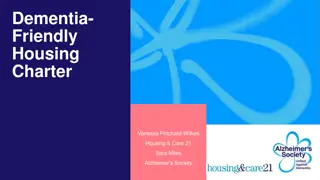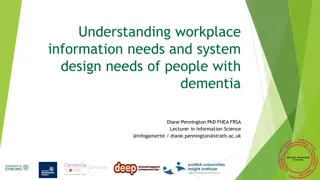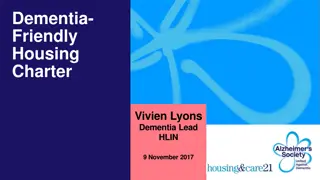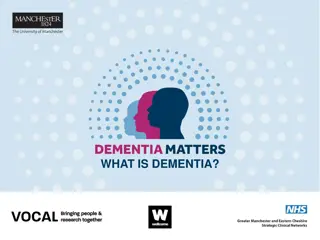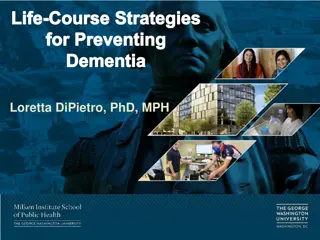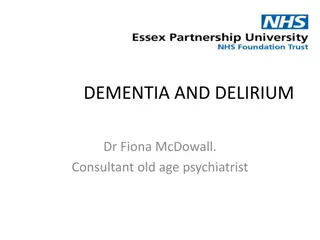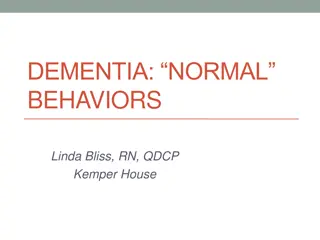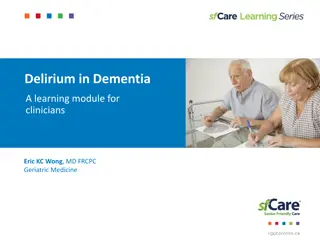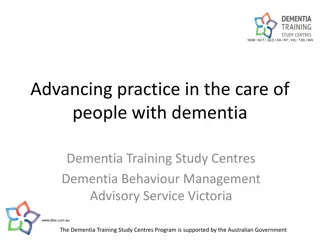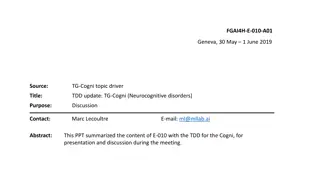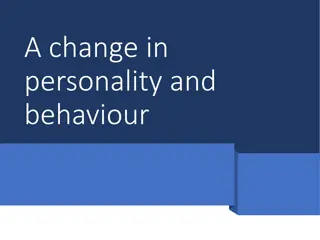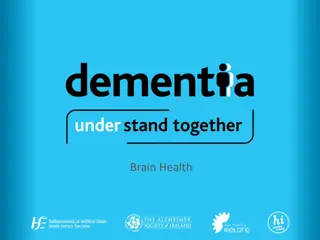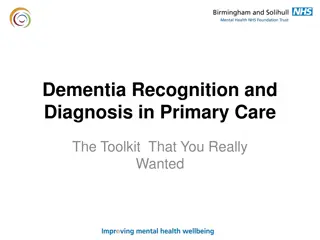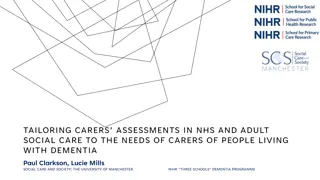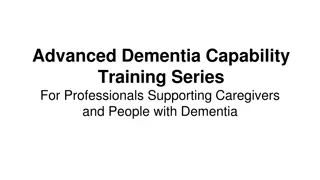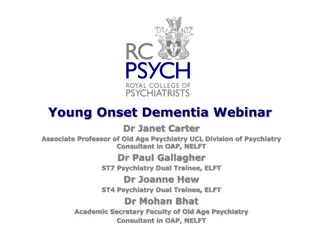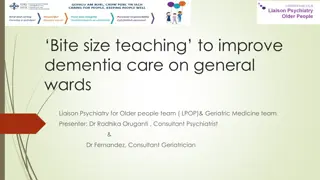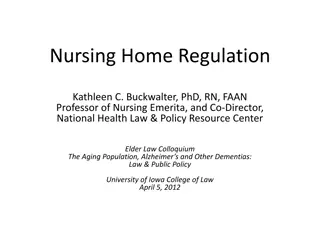Dementia-Friendly Dental Practice Environmental Audit Tool
This tool assesses physical and environmental factors impacting individuals with dementia in a dental practice setting. It aims to promote meaningful interactions and improve the overall experience for patients. Collaboration among various stakeholders facilitates a comprehensive evaluation, fostering constructive discussions and actions for enhancing dementia-friendly features. Utilizing this tool can lead to a more welcoming, accessible, and reassuring environment for individuals with dementia.
Uploaded on Sep 15, 2024 | 0 Views
Download Presentation

Please find below an Image/Link to download the presentation.
The content on the website is provided AS IS for your information and personal use only. It may not be sold, licensed, or shared on other websites without obtaining consent from the author. Download presentation by click this link. If you encounter any issues during the download, it is possible that the publisher has removed the file from their server.
E N D
Presentation Transcript
Practice Name_____________________ Is your dental practice dementia friendly? Audit tool for dental practice The environmental assessment tool has been designed to be practical and easy to use. It focuses on those aspects of the physical environment known to impact on people with dementia. It assesses both the physical environment (such as floor coverings and use of paint colours) and the way that the environment encourages people to behave and interact. Adapted from Kings fund EHE Environmental Assessment tool How to use the health centre assessment tool The assessment tool can be used by a single individual but involving others who have a different perspective, for example; people with dementia or a carer, clinical staff, practice managers or receptionists, can offer valuable opportunities for gaining different views on the care environment and how to improve it. Completing the tool together can also encourage constructive conversations about the philosophy and purpose of care.
The Assessment Tool How to use Why Audit? Many people with dementia, especially those with Alzheimer s disease, have difficulty in interpreting what they see and might for example think that a shiny floor is wet and or slippery. They may also struggle to understand unfamiliar environments so providing simple, cost effective, dementia friendly design features will help to reassure them whilst they are in the health centre. The assessment tool can be used by a single individual but involving others who have a different perspective, for example; people with dementia or a carer, clinical staff, practice managers or receptionists, can offer valuable opportunities for gaining different views on the care environment and how to improve it. Completing the tool together can also encourage constructive conversations about the philosophy and purpose of care. The assessment tool contains 9 sections and a set of questions to prompt discussions. It should be completed in full. Walk around the dental practice being assessed and consider each of the questions in turn. Give each question a score out of five, where five indicates that it is met completely and one indicates it is barely met. If any of the questions are not relevant they should be marked as not applicable N/A. It may be helpful to take photos as these can be used to record progress. Please make sure management permission has been agreed, particularly for shared buildings. The environmental assessment tool has been designed to be practical and easy to use. It focuses on those aspects of the physical environment known to impact on people with dementia. It assesses both the physical environment (such as floor coverings and use of paint colours) and the way that the environment encourages people to behave and interact. A summary sheet has been provided at the end of the assessment tool which should help pinpoint the areas that might be considered for initial improvement. Discuss the results at a team meeting and agree some actions that can be taken. These should be entered in your Dementia Action plan from the Dementia Action alliance.
1 Interaction The environment promotes meaningful interaction between patients, their families and staff. Please give examples of good practice/ areas of concern QUESTIONS Please score each answer from 1-5 (1=barely met, 5=totally met) Score A Does the approach to the building look and feel welcoming? B Is the entrance well signed and easy to find? Rationale Being unable to find the entrance and/or reception desk can cause anxiety. Uncared for an unwelcoming spaces can provide concerns. C Is there a ramp with handrails and is it clear of obstacles which may cause confusion- e.g. bicycles? D Does the building give a good first impression i.e. is it well lit, clean, tidy and cared for? Uncared for an unwelcoming spaces can provoke concerns in patients and their relatives about the standards of care. The arrangement of furniture procides cluses as to the purpose of the space. Seating that enables carers to sit longside the people they are accompanying will reduce agitation. E Is there an obvious main reception/enquiry desk near the entrance? F If this is a shared building with separate receptions are these easy to see and clearly signed? G Are seating/waiting areas obvious? H Is there a choice of seating provided including chairs with arms? Older people are likely to need chairs with arms. I Is there space for those accompanying patients to sit with them?
Please give examples of good practice/ areas of concern 2 Wellbeing Questions Please score each answer from 1-5 (1=barely met, 5=totally met) Score A Is the level of light comfortable and appropriate? The environment promotes wellbeing B Is the lighting even e.g. without pools of light and/or dark areas, stripes or shadows which could be confusing and disorientating? Rationale Older people need higher light levels and people with dementia may interpret shadows or dark area as holes in the floor or different levels and avoid or try to step over them. C Is there good natural light? D Is there good colour contrast between the chairs and the flooring? E Are there artworks to provide interest while waiting? F Are views of nature maximised e.g. by having low windows so people can see out from a seated position? Appropriate artworks can provide interest while waiting. Is there access to pleasant, safe outside space e.g. garden, courtyard or terrace? G Views and access to nature promote well-being. H Has planting been chosen to be non-toxic and to provide interest throughout the seasons? Planting should be colourful and non-toxic.
Please give examples of good practice/ areas of concern 3 Engagement Questions Please score each answer from 1-5 (1=barely met, 5=totally met) Score A Is there a separate quieter seating/waiting area which could be used by people with dementia and their carers? The environment encorages active engagement of people with dementia in their care B Are there appropriate facilities to enable a relative/carer to be present throughout the consultation and episode of care? Rationale People with dementia can become very anxious in unfamiliar environments but being able to have their carer with them throughout is likely to be reassuring. C If you have an electronic check-in system is it easy to use and easily visible? D If you have a call display is it easily visible from the seating area and separate from the TV screen? Noisy environments and patient call display systems which use RV screens can be misinterpreted. E Can people access water easily and freely? Keeping people calm will enable them to better participate in their care. Distress can be eased by providing a quiet waiting area or room. Avoiding dehydration is an important part of caring for people with dementia so having water available is helpful.
Please give examples of good practice/ areas of concern 4 Mobility Questions Please score each answer from 1-5 (1=barely met, 5=totally met) Score A Is the flooring matt rather than shiny and in a colour that contrasts with the walls and furniture? The environment promotes wellbeing B Could the lighting or natural light from windows make the floor appear to be wet or slippery? Rationale Older people need higher light levels and people with dementia may interpret shadows or dark area as holes in the floor or different levels and avoid or try to step over them. C Is the flooring a consistent colour i.e. does not have speckles, pebble effects, stripes or patterns? D Are any threshold strips or floor mats between areas in the same colour and tone as the flooring? Appropriate artworks can provide interest while waiting. E The handrails contrast with the walls and can they be grasped properly? Views and access to nature promote well-being. F Are staircases well lit and are stair edges in a contrasting colour to enable the edges of the steps to be clearly distinguishable? Planting should be colourful and non-toxic. If you have a lift are the controls easy to understand and clearly visible? G H Are dead ends avoided by putting a chair or artwork at the end of a long corridor? I Is there seating for people to rest outside or along long corridors?
Please give examples of good practice/ areas of concern 5 Hygiene Questions Please score each answer from 1-5 (1=barely met, 5=totally met) Score A Can the signs to the toilets be seen from all areas and are they easily recognisable and of a familiar design? The environment promotes continence and personal hygiene B Are all toilet doors painted in a single distinctive colour and do they have the same clear signage? Rationale Not being able to find the tiolet provokes anxiety and using the same signs and door colours to denote all toilets will help people find them more easily. Ensuring good colour contrast on sanitary fittings will make tiolets and basins easier to see and use. Traditional and familiar designs will help ease ansiety and promote self- care Being plunged into darkness if sensor lights go out can be very frightening. C Are the toilet seats, flush handles and rails in a colour that contrasts with the toilet walls and floor? D Are the toilet flushes and basins of a familiar design? E Are the toilet roll holders of a familiar design and can they be easily reached from the toilet? F Are the taps clearly marked as hot and cold and of a traditional design? On each floor is there access to a toilet big enough to allow space for a wheelchair and carers to assist with the door closed? G H If sensor lights have been installed do they allow sufficient time for completion of toileting?
Please give examples of good practice/ areas of concern 6 Orientation Questions Please score each answer from 1-5 (1=barely met, 5=totally met) Score A Do doors have a clear or transparent vision panel to show where they lead to? The environment helps people find their way around. B Are signs of a good size and a contrasting colour and hung at a height (approx 4 foot/1.2m) that makes viewing them easy? Rationale People with dementia are likely to become agitated in unfamiliar surroundings. Providing visual clues and prompts, including accent colours and artworks of local landmarks can help them find their way around. C Are signs denoting surgery number or name clear and easy to read? D Are signs placed at key decision points to assist navigation through the building? E Have strong patterns been avoided in wall coverings, curtains, furnishings and screens? Signs need to be placed at a height where they can easily be seen and should be placed on doors, not beside them. F Is there a large face clock easily visible in all areas? G Is there clear internal signage with the name and location of the practice. Strong patterns on walls, curtains or furnishings can be misinterpreted. Providing clocks and signs indicating the name and address of the practice will help orientation. H Are there points of interest and way finding clues throughout the practice-e.g. different colour or artwork on different floors?
Please give examples of good practice/ areas of concern 7 Safety Questions Please score each answer from 1-5 (1=barely met, 5=totally met) Score A Are notices kept to a minimum to avoid distraction and confusion? The environment promotes calm, safety & security B Are spaces clutter free? Rationale C Has adequate space been provided for wheelchairs and pushchairs? Clutter and distractions including notices can cause added confusion and should be avoided. D Are all the ways out/fire exits clearly marked and easy to see? Noise can make concentration difficult and can increase anxiety E Have noise absorbent surfaces been used e.g. on floors and ceilings to aid noise reduction? Locked doors and window restrictions can lead to frustration and anger when they cannot be opened. F Is background noise kept to a minimum? G Are doors to staff only area disguised (e.g. by painting the doors and door handles in the same colours as the walls? H Are all hazardous liquids and solids e.g. cleaning materials, locked away?
Please give examples of good practice/ areas of concern 8 Dental surgery Questions Please score each answer from 1-5 (1=barely met, 5=totally met) Score A Is there a number and name of the dental surgeon on the door into the surgery? The dental surgery environment promotes a safe and calm space where patients can receive excellent dental care Rationale Numbers and names on surgery doors promotes orientation and creates meaningful interaction between the patient and dentist. Additional seating in the surgery allows a patient to be comforted and reassured during dental treatment. B Is there a second chair, of adequate size, in the room for a carer or family member to accompany the patient? C Can the radio be muted to create a quiet environment so that a patient will not struggle to hear instructions? D Can the arm of the dental chair be adjusted to allow the patient to sit down easily? E Is there adequate natural light entering the dental surgery with no dark pools? Being able to create a quiet environment by muting a radio can reduce confusion and a patients agitation. F Is the dental chair a colour that contrasts with the surrounding clinical environment? Small adjustments in the surgery such as changing the position of the arm on the dental chair will encourage a patients mobility and confidence getting in and out of the chair. G Can you provide a bright coloured mouthwash to create contrast against a white spitoon? Opening blinds fully will ensure adequate natural light reaches the dental surgery and will not create shadows which can be interpreted as holes by patients with dementia. Where possible contrasting colours should be used to improve a patient s orientation.
Please give examples of good practice/ areas of concern 9Dental Care Questions Please score each answer from 1-5 (1=barely met, 5=totally met) Score People with dementia and their carers are treated with dignity and respect and their needs are met. A Has everyone in the practice undertaken dementia friends training? B Are patients with dementia offered an appointment at a quiet time if needed- e.g. just after lunch? Rationale Undertstanding the needs of people with dementia goes a long way to ensuring that they feel welcomed and understood. C Can the radio be muted to create a quiet environment so that a patient will not struggle to hear instructions? Advanced treatment planning is important in dentistry particularly when complex treatment is needed. D Is information made available in simple format- e.g. large font and pictorial? A quiet environment is less stressful for people with dementia and their carers- so a quiet time of day may be more appropriate E Is advanced care planning is undertaken for all older patients so that their wishes are known Familiarity is important both for the dental team and the person with dementia and their carers so where at all possible they should be treated by the same individuals from the dental team F Do patients with dementia see the same dental team members (dentist and dental nurse) at each visit? G Have you asked for feedback from patients with dementia and their families? Asking for and responding to feedback is the best way of ensuring that your service is welcoming for people with dementia.
Summary A B C D E F G H I Put your scores for each section Where you are low - consider what changes you can make. Look at the design principles on the next slide Identify 3-4 small changes that can be easily made in your practice and put in your dementia action alliance. 1. Interaction 2. Wellbeing 3. Engagement 4. Mobility 5. Hygiene 6. Orientation 7. Safety 8. Dental surgery 9. Dental Care
Design principles The design principles focus on promoting wellbeing and independence and bring together best practice. Some element can be changed at little or no cost and others can be planned for over a longer timeframe or incorporated into any building development. Identify 3-4 small changes that can be easily made in your practice and put in your dementia action alliance.
Practice Actions Action Who Timescale 1 2 3 4


